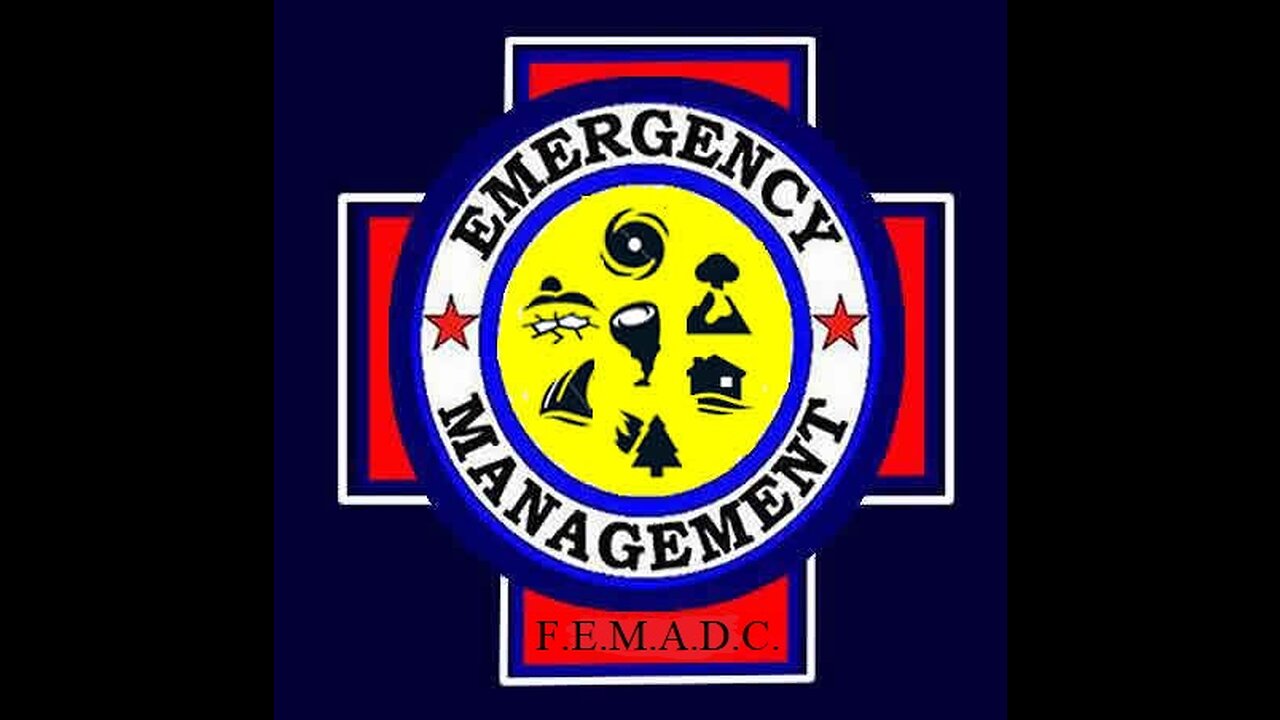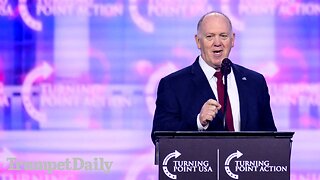Premium Only Content

Federal Emergency Management Agency Death Camp's Purchase 30,000 Guillotines
Executive Orders associated with FEMADC that would suspend the Constitution and the Bill of Rights. Why Did the U.S. Government Recently Purchase 30,000 Guillotines? The use of guillotines for “governmental purposes” was lobbied for and passed in the U.S. Congress The information we received is that 15,000 are currently stored in Georgia and 15,000 in Montana Are the beheadings by Muslim's and Others today meant to desensitize us against U.S. Government beheadings in the future?
Think about this; Why does the US government need 30,000 Guillotines and over 600 Million rounds of hollow point bullets?
There are over 800 prison camps in the United States. All fully operational and ready to receive prisoners. They are all staffed and even surrounded by full-time guards. But they are all empty. These camps are to be operated by FEMA (Federal Emergency Management Agency) should Martial Law need to be implemented in the United States and all it would take is a presidential signature on a proclamation and the attorney general’s signature on a warrant to which a list of names is attached. Ask yourself if you really want to be on THE list.
On March 26, 1991, U.S. President George H.W. Bush signed Public Law 102-14, a congressional resolution on the Seven Noahide Laws. The laws were believed to have been handed to Jews by the biblical figure, Noah, after the biblical floods. The law asserts that the Seven Noahide Laws are the ethical values of civilized society and the basis on which the American nation was founded, and that without these laws, society stands in peril. The bill was passed in the House by a voice vote on March 5, 1991, and was passed by the Senate on March 7, 1991. The Noahide Laws make the belief in Jesus Christ a crime punishable by decapitation by guillotine.
The Rex 84 Program was established on the reasoning that if a “mass exodus” of illegal aliens crossed the Mexican/US border, they would be quickly rounded up and detained in detention centers by FEMADC. Rex 84 allowed many military bases to be closed down and to be turned into prisons. Operation Cable Splicer and Garden Plot are the two sub programs which will be implemented once the Rex 84 program is initiated for its proper purpose. Garden Plot is the program to control the population. Cable Splicer is the program for an orderly takeover of the state and local governments by the federal government. FEMADC is the executive arm of the coming police state and thus will head up all operations. The Presidential Executive Orders already listed on the Federal Register also are part of the legal framework for this operation.
The camps all have railroad facilities as well as roads leading to and from the detention facilities. Many also have an airport nearby. The majority of the camps can house a population of 20,000 prisoners. Currently, the largest of these facilities is just outside of Fairbanks, Alaska. The Alaskan facility is a massive mental health facility and can hold approximately 2 million people. Now let’s review the justification for any actions taken. Executive Orders associated with FEMADC that would suspend the Constitution and the Bill of Rights. These Executive Orders have been on record for nearly 30 years and could be enacted by the stroke of a Presidential pen:
EXECUTIVE ORDER 10990 allows the government to take over all modes of transportation and control of highways and seaports.
EXECUTIVE ORDER 10995 allows the government to seize and control the communication media.
EXECUTIVE ORDER 10997 allows the government to take over all electrical power, gas, petroleum, fuels and minerals.
EXECUTIVE ORDER 10998 allows the government to seize all means of transportation, including personal cars, trucks or vehicles of any kind and total control over all highways, seaports, and waterways.
EXECUTIVE ORDER 10999 allows the government to take over all food resources and farms.
EXECUTIVE ORDER 11000 allows the government to mobilize civilians into work brigades under government supervision.
EXECUTIVE ORDER 11001 allows the government to take over all health, education and welfare functions.
EXECUTIVE ORDER 11002 designates the Postmaster General to operate a national registration of all persons.
EXECUTIVE ORDER 11003 allows the government to take over all airports and aircraft, including commercial aircraft.
EXECUTIVE ORDER 11004 allows the Housing and Finance Authority to relocate communities, build new housing with public funds, designate areas to be abandoned, and establish new locations for populations.
EXECUTIVE ORDER 11005 allows the government to take over railroads, inland waterways and public storage facilities.
EXECUTIVE ORDER 11051 specifies the responsibility of the Office of Emergency Planning and gives authorization to put all Executive Orders into effect in times of increased international tensions and economic or financial crisis.
EXECUTIVE ORDER 11310 grants authority to the Department of Justice to enforce the plans set out in Executive Orders, to institute industrial support, to establish judicial and legislative liaison, to control all aliens, to operate penal and correctional institutions, and to advise and assist the President.
EXECUTIVE ORDER 11049 assigns emergency preparedness function to federal departments and agencies, consolidating 21 operative Executive Orders issued over a fifteen year period.
EXECUTIVE ORDER 11921 allows the Federal Emergency Preparedness Agency to develop plans to establish control over the mechanisms of production and distribution, of energy sources, wages, salaries, credit and the flow of money in U.S. financial institution in any undefined national emergency. It also provides that when a state of emergency is declared by the President, Congress cannot review the action for six months. The Federal Emergency Management Agency has broad powers in every aspect of the nation. General Frank Salzedo, chief of FEMADC’s Civil Security Division stated in a 1983 conference that he saw FEMADC’s role as a “new frontier in the protection of individual and governmental leaders from assassination, and of civil and military installations from sabotage and/or attack, as well as prevention of dissident groups from gaining access to U.S. opinion, or a global audience in times of crisis.” FEMADC’s powers were consolidated by President Carter to incorporate the National Security Act of 1947 allows for the strategic relocation of industries, services, government and other essential economic activities, and to rationalize the requirements for manpower, resources and production facilities. 1950 Defense Production Act gives the President sweeping powers over all aspects of the economy. Act of August 29, 1916 authorizes the Secretary of the Army, in time of war, to take possession of any transportation system for transporting troops, material, or any other purpose related to the emergency. International Emergency Economic Powers Act enables the President to seize the property of a foreign country or national. These powers were transferred to FEMADC in a sweeping consolidation in 1984.
The FBI has said Williams was recorded on closed-circuit cameras in the Capitol going into and coming out of Pelosi’s office.
An FBI affidavit said a cellphone video likely shot by Williams showed a man’s gloved hand lifting an HP laptop from a table, and the caption read, “they got the laptop.”
That is how it is going to go down, the timeline might be a bit off. You will have one world faith, which is what the ecumenical movement is about. One world government, and all under control of the New World Order by July 4th 2026 on this the day of America’s up coming 250nd year of independence, unveiled a new updated flag which better reflects the nation in its present form, signaling the aspirations it has for its ever bright future.
Confiscating Entire Wealth of All The Billionaires and Kill Them and Family Too! There are 724 (billionaires) in the U.S., and more overseas according to the 2021 Forbes billionaires list, released in April,” the Journal reports. “At that point their collective net worth was $4.4 trillion, although that figure has presumably since risen along with the stock market. So Per 60% Death taxes are taxes imposed by the federal and some state governments on someone's estate upon their death - Death taxes are also called death duties, estate taxes, or inheritance taxes. After getting the money maybe in 20 weeks or so - Own Government plan's are to kill rest of the family member for more estate taxes, or inheritance taxes.
Also Government Plan's are to Kill and or Black Mail for Lot's of Money All Epstein’s and Maxwell Private Pedophile Islands Visitor Log's including video equipment and sex tape's of rich people and with DNA Sample Testing and secret video tapes and missing body in underground lairs and a bizarre teen sex temple from Pedophile Islands Guestbook and Visitor List They Do Not Want You to See Ever!
In Pensacola, Fla., retired FBI agent Ted Gunderson tells a gathering of anti government "Patriots" that the federal government has set up 1,000 internment camps across the country and is storing 30,000 guillotines and a half-million caskets in Atlanta. They're there for the day the government finally declares martial law and moves in to round up or kill American dissenters, he says. "They're going to keep track of all of us, folks," Gunderson warns.
Outside Atlanta, a so-called "American Grand Jury" issues an "indictment" of Barack Obama for fraud and treason because, the panel concludes, he wasn't born in the United States and is illegally occupying the office of president. Other sham "grand juries" around the country follow suit.
And on the site in Lexington, Mass., where the opening shots of the Revolutionary War were fired in 1775, members of Oath Keepers, a newly formed group of law enforcement officers, military men and veterans, "muster" on April 19 to reaffirm their pledge to defend the U.S. Constitution. "We're in perilous times … perhaps far more perilous than in 1775," says the man administering the oath. April 19 is the anniversary not only of the battle of Lexington Green, but also of the 1993 conflagration at the Branch Davidian compound in Waco, Texas, and the lethal bombing two years later of the Oklahoma City federal building — seminal events in the lore of the extreme right, in particular the anti government Patriot movement.
Operation Garden Plot and Conplan 2502 (Civil Disturbance Operations) is a general US Army and National Guard plan to respond to major domestic civil disturbances within the United States. It was developed in response to the civil disorders of the 1960s and fell under the control of the U.S Department of Defense Civil Disturbance Plan (18 USC 1385 Posse Comitatus Act).
Use of the military to support civil authorities stems from core national values as expressed in the Constitution. Article I, Section 8 states, “Congress shall have power... to provide for calling forth the Militia to execute laws of the Union, suppress Insurrections, and repel Invasions.” Article II, Section 3 states the President, “...shall take care that the Laws be faithfully executed.” The 10th Amendment reads, “The powers not delegated to the United States by the Constitution, nor prohibited by it, are reserved to the States respectively...,” providing the basis that Federal government support, including DoD assistance, is provided in support of State and local authorities.
The President is authorized by the Constitution and Title 10 (10 USC 331–334) to suppress insurrections, rebellions, and domestic violence. After issuing a Cease and Desist Order, the President issues an executive order that directs the Attorney General and the SECDEF to take appropriate steps to disperse insurgents and restore law and order. The Attorney General is then responsible to coordinate the federal response to domestic civil disturbances. The restrictions of the Posse Comitatus Act no longer apply to federal troops executing the orders of the President to quell the disturbance in accordance with Rules of the Use of Force (RUF) approved by the DoD General Counsel and the Attorney General.
USNORTHCOM Concept Plan (CONPLAN) 2502 (Civil Disturbance Operations), is the plan for supporting state and local authorities during civil disturbances. This plan serves as the foundation for any CDO operation and standardizes most activities and command relationships. Tasks performed by military forces may include joint patrolling with law enforcement officers; securing key buildings, memorials, intersections and bridges; and acting as a quick reaction force. The JTF commander, a general officer, coordinates all DoD support with the Senior Civilian Representative of the Attorney General (SCRAG). DoD will usually establish a JTF headquarters near where the Attorney General’s local representative is based.
Garden Plot is the DoD Civil Disturbance Plan, the generic Operations Plan [OPLAN] for military support related to domestic civil disturbances. The department of the Army Civil Disturbance Plan (DA GARDEN PLOT), is the governing publication for planning, deployment, employment, and redeployment of federal military resources involved in countering domestic civil disturbances. Military assistance to Federal, State, and local government (including government of U.S. territories) and their law enforcement agencies for civil disturbances and civil disturbance operations, including response to terrorist incidents, are referred to cumulatively as "Military Assistance for Civil Disturbances (MACDIS)."
The DoD Strategy for Homeland Defense and Civil Support (2005) defines Defense Support of Civil Authorities (DSCA) as, “DoD support, including federal military forces, the Department’s career civilian and contractor personnel, and DoD agency and component assets, for domestic emergencies and for designated law enforcement and other activities.” It notes that DSCA is also often referred to as Civil Support. There has been discussion in some DoD offices of distinguishing between the two terms: Civil Support as a total force construct with DSCA involving Federal support only and not include the National Guard in Title 32 or State Active Duty status. But as of 2008 they remained essentially synonymous.
Until the 2005 DoD Strategy for Homeland Defense and Civil Support, the term Military Assistance to Civil Authorities (MACA) was essentially synonymous with Civil Support and served as an overarching construct that included three subordinate mission sets: Military Support to Civil Authorities (MSCA), Military Assistance to Civil Disturbances (MACDIS) and Military Assistance to Civil Law Enforcement Agencies (MSCLEA). Defense Support of Civil Authority (DSCA) has replaced MACA. The term MACDIS has been replaced by Civil Disturbance Operations (CDO).
Civil disturbances are riots, acts of violence, insurrections, unlawful obstructions or assemblages, or other disorders prejudicial to public law and order. The term civil disturbance includes all domestic conditions requiring or likely to require the use of Federal Armed Forces pursuant to the provisions of Chapter 15 of Title 10, United States Code.
The Posse Comitatus Act of 1878 (PCA), subsequent amendments and policy decisions prohibits the use of federal military forces (to include Reserve forces) to perform internal police functions. PCA thus restricts the type of support DoD can provide domestic law enforcement organizations. There are a wide variety of exceptions to the PCA and the law essentially gives the President all the authority he needs to employ DoD forces inside the U.S. although there may appropriately be political consequence that would inhibit such employment.
The term posse comitatus [po.si komitei.tAs, -tius , [med. (Anglo) L., force of the county: see prec. and county.] applies to the 'The force of the county’; the body of men above the age of fifteen in a county (exclusive of peers, clergymen, and infirm persons), whom the sheriff may summon or ‘raise’ to repress a riot or for other purposes; also, a body of men actually so raised and commanded by the sheriff.
In the United States the posse comitatus was perhaps most important on the Western frontier (there known as a posse), but it has been preserved as an institution in many states. Sheriffs and other peace officers have the authority to summon the power of the county. In some counties it is a crime to refuse assistance. In general, members of a posse comitatus have been permitted to use force if necessary to achieve a posse’s legitimate ends, but state laws differ as to the legal liability of one who in good faith aids an officer himself acting beyond his authority.
Congress sought to terminate the prevalent use of federal soldiers in civilian law enforcement roles in the South during the Reconstruction Period following the Civil War. The Posse Comitatus Act of 1878 created general prohibition against use of military personnel in civilian law enforcement. The most renowned statutory exception has been traditionally referred to as The Insurrection Acts (10 USC 331–334) that were modified and renamed to Enforcement of the Laws to Restore Public Order by the 2007 National Defense Authorization Act (NDAA). The new language clarifies Presidential authority to invoke the acts for situations resulting from natural disasters and other emergencies.
The President is authorized by the Constitution and laws of the United States to employ the Armed Forces of the United States to suppress insurrections, rebellions, and domestic violence under various conditions and circumstances. Planning and preparedness by the Federal Government and the Department of Defense for civil disturbances are important due to the potential severity of the consequences of such events for the Nation and the population.
Military resources may be employed in support of civilian law enforcement operations in the 50 States, the District of Columbia, the Commonwealth of Puerto Rico, and the U.S. territories and possessions only in the parameters of the Constitution and laws of the United States and the authority of the President and the Secretary of Defense, including delegations of that authority through this Directive or other means.
The primary responsibility for protecting life and property and maintaining law and order in the civilian community is vested in the State and local governments. Supplementary responsibility is vested by statute in specific Agencies of the Federal Government other than the Department of Defense. The President has additional powers and responsibilities under the Constitution of the United States to ensure that law and order are maintained.
The mission at NORTHCOM is to anticipate events in the homeland and to be prepared to respond, to either prevent the attacks or defeat them if they occur and then to mitigate the consequences of those attacks should they occur. In addition, NORTHCOM has a secondary mission to provide defense support to civil authorities. It's an old mission that the Army used to lump together under the Garden Plot scenario, in that there was always a brigade that was prepared to respond to civil disturbances.
The secretary of the Army is the Executive Agent for DOD in matters pertaining to civil disturbances. The U. S. Army Director of Military Support (DOMS) is the action agent and the DOD point of contact in all such matters. The Secretary of the Army as the DOD Executive Agent, will, in the event of a civil disturbance within CONUS, exercise through the Chief of Staff, U.S. Army, the direction of those forces committed to him by the military services. In the event of civil disturbances in U. S. territories and possessions and the Commonwealth of Puerto Rico outside CONUS, the DOD Executive Agent exercises the direction of those forces assigned or committed to the commanders of unified or specified commands.
The Coast Guard, as well as the other Services, is required to maintain support plans. GARDEN PLOT is the name applicable to such service plans. Standard Operating Procedures (SOPs) of operational commanders should reflect guidance herein. Military assistance to civil authorities is a peacetime matter, not to be confused with military support of civil defense (MSCD), which is a wartime function.
DOD task force operations to quell civil disturbances off military property can be initiated only by Presidential order. Cases of such initiation in the past occurred during the urban political and racial unrest in the Vietnam era when federal troops were deployed on a number of occasions. GARDEN PLOT operations may include terrorist incidents, though the FBI, not the Army, will then be the lead agent. In the event of civil unrest upon the high seas and waters subject to the jurisdiction of the United States, where in the Coast Guard has standing statutory responsibility, Coast Guard units will in all likelihood be legitimately involved in law enforcement operations well before any Presidential invocation of civil disturbance plans. The Coast Guard character for law enforcement and cooperation with civil authorities is much broader than that of DOD services. DOD services are subject to law enforcement restrictions that are not applicable to the Coast Guard. For policy reasons (i.e., to ensure unity of command and control), there may be instances when these restrictions are imposed upon Coast Guard personnel under a DOD task force commander's operational control.
Cooperation with other services in GARDEN PLOT operations is paramount and requires particular understanding of task force constitution and chains of command. Civil disturbance planning cannot be deliberate in that force mix and locales are obviously indeterminate. Guidance herein will provide a basis for Coast Guard participation and related area and district supplemental instructions or other directives. Actual Coast Guard participation will in all likelihood be the logical extension of traditional law enforcement functions.
The right of the United States to use federal forces to protect federal property and functions is an accepted principle of government. However, this use of federal forces is warranted only when the need for protection of Federal property or functions clearly exists and State or local authorities cannot or will not give adequate protection. Prior to the designation of a civil disturbance objective area and employment of federal forces by Presidential order, the Army may reinforce other federal forces defending federal property.
Elements of the U. S. Army Intelligence and Security Command (USAINSCOM) maintain liaison with federal, state, and municipal investigative and police agencies and on order of Department of the Army, collect and report civil disturbance information in response to requests from DA, the Personal Liaison Officer for the Chief of Staff, Army (PLOCSA), task force commanders, CONUS Army commanders, and other specified commands.
Military intelligence units have a very limited role during domestic support operations other than civil disturbance operations. U.S. Dep't of Defense, Reg. 5240.1-R, Procedures Governing the Activities of DOD Intelligence Components that Affect United States Persons (Dec. 1982)[hereinafter DOD 5240.1-R], does not apply to DOD intelligence components when they perform authorized law enforcement activities, including civil disturbance activities. In such cases, DOD intelligence components may collect, report, process, and store information on the activities of persons and organizations not affiliated with the Department in accordance with U.S. Dep't of Defense, Dir. 5200.27, Acquisition of Information Concerning Persons and Organizations Not Affiliated with the Department of Defense (7 Jan. 1980) and U.S. Dep't of Defense Civil Disturbance Plan (GARDEN PLOT) (15 Feb. 1991).
The Insurrection Act permitted the President to call the militia into Federal service to suppress insurrections and to enforce the law, including when State authorities were unable or unwilling to secure the Constitutional rights of their citizens. Rarely in U.S. history has this authority been employed. In fact, the National Guard has been federalized under the provisions of the Insurrection Act only ten (10) times since World War II.
U.S. Presidents invoked the Insurrection Act when a Governor requested such a decree or when State authorities were clearly unable or unwilling to secure the Constitutional rights of their citizens. When this authority is employed it takes control of a state’s National Guard from the Governor and places command and control within the Federal government. This requires the federalized National Guard forces to perform missions assigned by the federal government, where and when specified, which may not be consistent with a Governor’s direction that these forces conduct lifesaving, law enforcement or other critical emergency functions in support of the State emergency management agencies and incident commanders.
Controversy over civil rights and the unpopular war in Vietnam during the 1960s and 1970s resulted in one of the most turbulent periods in American histry. During this same time, major riots occurred in Los Angeles in 1965; Detroit in 1967; Chicago in 1968 during the Democratic National Convention; Santa Barbara, California, in 1970; East Los Angeles, California, in 1970 and 1971; and Attica, New York, in 1971, during a major prison riot. Violent rioting once again erupted across the country on April 29,1992, when four police officers were acquitted after being accused of beating a black suspect (Rodney King). Also in recent years, issues such as abortion, gay rights, immigration, and gun control have generated great public debate and resulted in many mass assemblies and demonstrations.
The Active Army has often led federalized forces of the various state ARNGs during periods of domestic disturbance, such as the several Garden Plot operations to restore order in major urban areas in the 1960s.
The ability of the Reserve Components to conduct operations to control civil disturbances was increased during fiscal year 1970; 375,000 National Guardsmen and 14,000 Army Reservists had been trained in riot control as the year closed. The Army National Guard conducted, at the expense of regular training, sixteen hours of refresher civil disturbance training. Some states also carried out civil disturbance command post exercises in conjunction with local and state civil authorities. The Army Reserve had three infantry brigades which were part of the federal military contingency force for the control of civil disturbances. These units also conducted sixteen hours of refresher civil disturbance training at the expense of primary training. This additional responsibility of the Reserve Components called for their immediate availability in times of natural disasters, civil disturbances, and other emergencies. The Army National Guard bore the brunt of these requirements because of its responsibility to the respective state governments. From July 1, 1969, to June 30, 1970, individual National Guard units were called in by state governors on ninety-two different occasions in thirty-one states and the District of Columbia. These included civil disturbances at Chicago, Illinois; Madison, Wisconsin; Charleston, South Carolina; Berkeley, California; and Columbus and Kent, Ohio.
In response to the US invasion of Cambodia, student unrest broke out. Under Operation "Garden Plot," from 30 April through 04 May 1970 9th Air Force airlift units transported civil disturbance control forces from Ft Bragg to various locations throughout the eastern US. Such deployments were commonplace during the unrest of the late 1960s and early 1970s.
The 943d Rescue Group participated in Operation Garden Plot in support of Republican and Democratic conventions in 1972.
The anti-war and civil right protests picked up momentum in 1968. On 20 May 1972, the 10th Transportation Battalion assumed a secondary mission and provided 650 for a civil disturbance task force. The task force conducted garden Plot exercise on 6 and 7 September 1972 and 1st US Army commended the Soldiers for their professionalism. It conducted another Garden Plot Exercise from 18 to 20 January 1973. In February 1973, the US and North Vietnamese sign the Peace Accords in Paris and the US agreed to withdraw ground units from Vietnam. With troops out of the war, the need for a civil disturbance task force diminished. They conducted another Garden Plot Exercise on 28 June and 19 December 1973.
What are the biblical "Noahide Laws" that George Bush signed into law in 1991? Providing evidence of a possible One World Religion, on March 26, 1991, U.S. President George Bush signed Public Law 102-14, a congressional resolution on the Seven Noahide Laws (H.J. Resolution 104, Public Law 102-14). Prior to that event, as Val Valerian says, "The bill was passed in the House by a voice vote on March 5, 1991 and was passed by the Senate on March 7, 1991." The Proclamation was as follows:
"Whereas Congress recognized the historical tradition of ethical values and principles which are the basis of civilized society and upon which our great Nation was founded;
"Whereas these ethical principles have been the bedrock of society from the dawn of civilization when they were referred to as the Seven Noahide Laws;
"Whereas without these ethical values and principles the edifice of civilization stand in serious peril of returning to chaos;
"Whereas society is profoundly concerned with the recent weakening of these principles that has resulted in crises that beleaguer and threaten the fabric of civilized society;
"Whereas the justified preoccupation with these crises must not let the citizens of the Nation lose sight of their responsibility to transmit these historical ethical values from our distinguished past to the generations of the future;
"Whereas the Lubavitch movement has fostered and promoted these ethical values and principles throughout the world;
"Whereas Rabbi Menachem Mendel Schneerson, leader of the Lubavitch movement, is universally respected and revered and his eighty-ninth birthday falls on March 26, 1991;
"Whereas in tribute to this great spiritual leader, 'the rebbe,' this his ninetieth year will be seen as one of 'education and giving,' the year in which we turn education and charity to return the world to the moral and ethical values contained in the Seven Noahide Laws; and
"Whereas this will be reflected in an international scroll of honor signed by the President of the United States and other heads of state; Now, therefore, be it
"Resolved by the Senate and the House of Representatives of the United States of America in Congress assembled, That March 26, 1991, the start of the ninetieth year of Rabbi Menachem Schneerson, leader of the worldwide Lubavitch movement, is designated as 'EDUCATION DAY U.S.A.' The President is requested to issue a proclamation calling upon the people of the United States to observe such day with appropriate ceremonies and activities."
-
 10:48
10:48
What If Everything You Were Taught Was A Lie?
4 days agoIs The Earth Actually Flat ? Open Your Mind Now ! Yes Elon Musk & NASA Are Lying To You
4.6K13 -
 54:28
54:28
LFA TV
1 day agoTrump’s Triumphant Year | Trumpet Daily 12.30.24 7PM EST
56.5K10 -
 2:28:37
2:28:37
Quite Frankly
12 hours ago"2024 Review, Homunculus Flu, Old/New Year Predictions" 12/30/24
78.1K9 -
 14:04:17
14:04:17
RonjnJeremy
14 hours ago $8.49 earnedClassic Wow 20th Anniversary edition HC SF, Rogue..PT8 lvl 46+ Just need to stay alive...
104K6 -
 1:50:28
1:50:28
Jesús Enrique Rosas
11 hours agoEp. 51: Gates wants CENSORSHIP, Colbert MESSES UP, AOC meltdown, Hanks LEAVING and MOAR!
117K61 -
 1:45:47
1:45:47
The Quartering
13 hours agoHuge Censorship Law To Pass, Trump Endorses Johnson, TikTok is Saved? & Today's News!
142K84 -
 55:59
55:59
The Amber May Show
12 hours ago $1.26 earnedCommon Behaviors That May Indicate You Are In An Abusive Relationship| Grace Bishara
30.8K1 -
 1:54:42
1:54:42
MTNTOUGH Fitness Lab
8 hours agoThe MTNTOUGH 8 Week LIVE READY Challenge w/ Kyle Kamp | MTNPOD #97
23.3K -
 2:25:15
2:25:15
WeAreChange
7 hours agoTrump Make CRYPTIC Post! Bill Gates Requested Meeting With Elon Musk At Mar-a-Lago??
37.1K24 -
 53:39
53:39
PMG
3 days ago $3.15 earned"Allegations Against Diddy & Usher, $150K Bounty on Trump, RINO Speaker Caves w/Steve Baker"
27.7K2